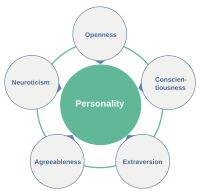
Photo from wikipedia
OBJECTIVE Alcohol use problems are common during adolescence and can predict serious negative outcomes in adulthood, including substance dependence and psychopathology. The current study examines the notion that alcohol use… Click to show full abstract
OBJECTIVE Alcohol use problems are common during adolescence and can predict serious negative outcomes in adulthood, including substance dependence and psychopathology. The current study examines the notion that alcohol use problems are driven by polygenic influences and that genetic influences may indirectly affect alcohol use problems through multiple pathways of risk, including variations in personality. METHOD We used a genome-wide approach to examine associations between genetic risk for alcohol use problems, personality dimensions, and adolescent alcohol use problems in two separate longitudinal population-based samples, the Finnish Twin Cohort (FinnTwin12) and the Avon Longitudinal Study of Parents and Children (ALSPAC). Participants were 1,035 young adults from FinnTwin12 and 3,160 adolescents from ALSPAC. Polygenic risk scores (PRS) were calculated for ALSPAC using genome-wide association results (on alcohol dependence symptoms as defined by the Diagnostic and Statistical Manual of Mental Disorders, Fourth Edition) from FinnTwin12. A parallel multiple mediator model was tested to examine whether the association between PRS and alcohol use problems assessed at age 16 could be explained by variations in personality dimensions assessed at age 13, including sensation seeking and negative emotionality. RESULTS PRS were marginally predictive of age 16 alcohol use problems; this association was partially mediated by sensation seeking. Polygenic variation underlying risk for alcohol use problems may directly influence the effects of sensation seeking, which in turn influence the development of alcohol use problems in later adolescence. CONCLUSIONS These findings contribute to the increasing evidence regarding the salience of sensation seeking during early adolescence as a potential constituent in the risk pathway underlying the development of alcohol use problems.
Journal Title: Journal of studies on alcohol and drugs
Year Published: 2017
Link to full text (if available)
Share on Social Media: Sign Up to like & get
recommendations!